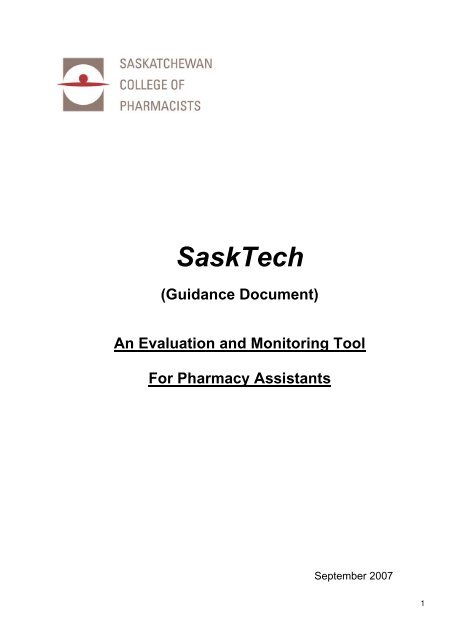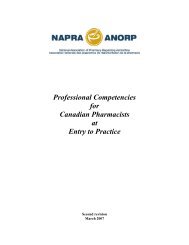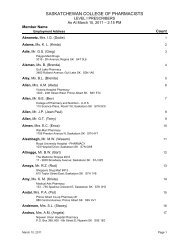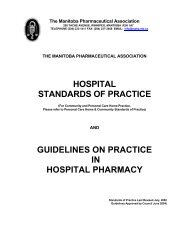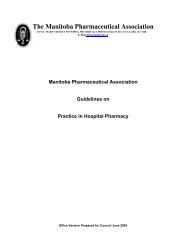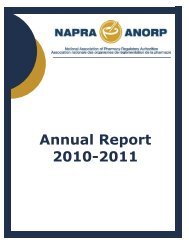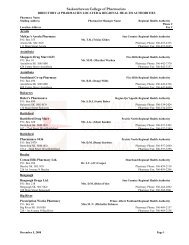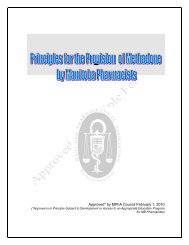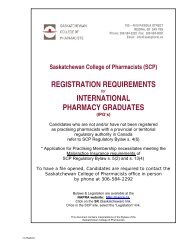SaskTech - NAPRA
SaskTech - NAPRA
SaskTech - NAPRA
Create successful ePaper yourself
Turn your PDF publications into a flip-book with our unique Google optimized e-Paper software.
<strong>SaskTech</strong><br />
(Guidance Document)<br />
An Evaluation and Monitoring Tool<br />
For Pharmacy Assistants<br />
September 2007<br />
1
TABLE OF CONTENTS<br />
Page<br />
Introduction ................................................................................................3<br />
Pharmacy Assistant/Technician Training Programs ............................. 4<br />
Pharmacy Assistant Functions.................................................................5<br />
1) Technical Role ..............................................................................5<br />
2) Expanded Role..............................................................................7<br />
3) Conduct ......................................................................................... 8<br />
References..................................................................................................9<br />
Appendix - TechWise Survey (November 2002) Abstract .................... 10<br />
2
Introduction<br />
Today’s society demands that all things are available at all hours, including pharmacy<br />
services. With a pharmacist shortage, extended pharmacy hours and a population that is<br />
aging, pharmacists are extremely busy. More importantly other forces are creating an<br />
increased demand on the pharmacist to perform in an optimal role. To assist the<br />
pharmacist in meeting these challenges, many functions may be assigned to pharmacy<br />
assistants to allow pharmacists to concentrate on other duties such as providing<br />
pharmaceutical care to their patients.<br />
This document has been adapted to suit the needs of Saskatchewan pharmacists from a<br />
document developed by the College of Pharmacists of British Columbia. The Council of<br />
The College of Pharmacists of British Columbia has identified an opportunity to use<br />
pharmacy assistants and developed the TechWise Project to assist pharmacists. This<br />
package contains information that was developed from the TechWise Project of B.C. to<br />
assist pharmacists in hiring qualified assistants to meet the needs of their pharmacy;<br />
specifying functions an assistant may perform if that is within their training, skills and<br />
abilities, and questions which may be used to assess the skills and knowledge of<br />
assistants.<br />
The purpose of this document is to provide a tool when hiring assistants and as an on-going<br />
evaluation or monitoring tool. This tool may be used “as is”, or as a starting point for<br />
developing such a document specific to that site. This document contains two sections of<br />
questions, the first dealing with assistant training, and the second dealing with knowledge<br />
assessment. A list of functions that an assistant may perform based on the pharmacist’s<br />
assessment is also included in this document; however these functions are to be assigned<br />
to assistants at the discretion of the pharmacist. Pharmacists may use this tool to hire<br />
assistants that are most suited to their practice, and appropriately employ assistants for<br />
non-professional duties and functions.<br />
The appendix contains an abstract of the TechWise Survey from November 2002. A more<br />
detailed description of the survey results is available on the website of the College of<br />
Pharmacists of British Columbia at www.bcpharmacists.org.<br />
3
Pharmacy Assistant/Technician Training Programs<br />
There are numerous post-secondary pharmacy technician training programs available<br />
throughout Canada. With the absence of national or provincial quality assurance standards<br />
for curriculum content and educational outcomes, the employers of pharmacy assistants<br />
are left with the task of evaluating both the qualifications of potential employees, as well as<br />
their ability to apply the training, either formal or informal, in everyday practice.<br />
Research shows that assistant/technician training programs vary in many areas. There are<br />
part-time, full-time and correspondence programs currently offered in many jurisdictions.<br />
These programs range in length from about six months to one year or more with no<br />
measurable correlation to standardized educational outcomes. Some of these programs<br />
have practicum components while others have no practicums at all. Some of the programs<br />
may include aseptic training, hands-on dispensing labs, and compounding techniques with<br />
the amount of time devoted to these activities varying widely.<br />
Currently in Saskatchewan training of pharmacy assistants is not required, and many<br />
assistants have on-the-job training. A pharmacy technician training program is offered at<br />
the Saskatchewan Institute of Applied Science and Technology (SIAST). This program is a<br />
38 week program that offers courses in communications, pharmacy law, pharmaceutical<br />
calculations, dispensing, and computer skills, among many others. This program also has<br />
a community and a hospital pharmacy practicum. While SCP does not endorse or accredit<br />
any pharmacy technician training programs, the program head of the SIAST program is<br />
confident that the graduates from this program would be knowledgeable in the areas<br />
addressed in this document. More information on the course is offered at www.siast.sk.ca.<br />
Even with formal training, assistants may not meet the specific needs of a pharmacy, and<br />
therefore more training may be required.<br />
This information is not to endorse or discredit any particular program. Instead, it is meant to<br />
educate and inform pharmacists who are looking for particular qualifications and skills in job<br />
applicants. The questions that follow later in this document have been developed to help<br />
an employer determine if an applicant's training is suitable to the practice environment and<br />
to identify learning gaps to be addressed.<br />
4
Pharmacy Assistant Functions<br />
An “assistant” is defined as a person who is not a pharmacist or intern, and who is<br />
employed in a pharmacy to assist the pharmacist in performing functions.<br />
The title “Technician” may be used if the assistant is legally certified or registered as<br />
such, or successfully completes a training program accredited by an agency<br />
acknowledged by the Saskatchewan College of Pharmacists.<br />
1) Technical Role<br />
The following is a list of technical functions which may be assigned to a pharmacy assistant<br />
at the pharmacist’s discretion. The pharmacist may allow these functions to be completed<br />
by an assistant if the pharmacist is satisfied that the assistant has had adequate training,<br />
either formal or informal, and is competent to perform these tasks. These functions may be<br />
performed by an assistant only under the direct supervision of a pharmacist. This means<br />
that the pharmacist is present and working directly with the assistant. The pharmacist is<br />
ultimately responsible for the quality and accuracy of these functions. The ratio of<br />
pharmacist to assistant working in the pharmacy and performing these functions is limited<br />
to 1:1, excluding interns.<br />
• obtain patient consent, where required<br />
• accept written prescriptions or refill requests from the patient or the patient’s<br />
representative<br />
• collect all relevant patient demographics, including known allergies<br />
• verify accuracy and completeness of demographic, allergy, and prescription data<br />
• input patient, third-party insurance, and prescription information into the computer<br />
• confirm that the pharmacist has had the opportunity to review the prescription and<br />
patient profile or health record<br />
• refer therapeutic issues and questions to the pharmacist<br />
• select the product or products needed and check the expiry date(s)<br />
5
• take the medication from the shelf to the work area<br />
• calculate, convert, and document the result of dosage calculations<br />
• verify calculations with the pharmacist<br />
• count, measure, weigh and / or pour medications<br />
• reconstitute medications<br />
• adhere to clean, or where required, aseptic techniques<br />
• verify accuracy and appropriateness of ingredients and quantities, including weights<br />
and volumes<br />
• verify the accuracy and completeness of a pharmaceutical product prepared for<br />
release<br />
• select type of prescription container<br />
• label container, including relevant auxiliary labels<br />
• pre-package pharmaceuticals<br />
• prepare extemporaneous compounds<br />
• prepare bulk manufactured products<br />
• confirm that the pharmaceutical product has been checked and signed off by a<br />
pharmacist<br />
• provide appropriate patient information materials, where specified by the pharmacist<br />
• confirm that the patient or patient’s representative has received or has been offered<br />
counselling by the pharmacist<br />
• follow procedures for the proper storage, handling, preparation, distribution, removal,<br />
and disposal of drugs<br />
• replenish stock bottles<br />
• maintain storage facilities<br />
• manage inventory<br />
• prepare receipts and claim forms<br />
• transcribe prescription data to patient medication profiles (manual or electronic),<br />
which is to be checked and initialed by the supervising pharmacist<br />
• file prescriptions as required by law, and pharmacy policy<br />
• record Narcotic and Controlled Drug entries as required by law<br />
• direct patients to the location of non-prescription medications<br />
• act as a role model and mentor<br />
6
2) Expanded Role<br />
The assistant may perform functions beyond the technical role described above within<br />
his/her competencies when the following conditions as outlined in a. and b. are fulfilled:<br />
a. The pharmacy manager can demonstrate that adequate quality assurance measures<br />
are in place in the pharmacy to permit the assistant to function in an expanded role.<br />
Quality assurance management must incorporate standards for training, certification,<br />
recertification, and outcomes assessment; and,<br />
b. The assistant scores at least 80% on the questions in this document, or is a<br />
graduate from a program accredited by a credible agency, or is certified by a credible<br />
agency, both of which are acknowledged by the Saskatchewan College of<br />
Pharmacists.<br />
This document is a competency based tool that members can use to hire qualified<br />
assistants to meet the needs of your practice, and as an ongoing evaluation and monitoring<br />
tool to deploy qualified assistants into more optimal or expanded support roles. The latter<br />
can be achieved through quality assurance measures and the assistant scoring at least<br />
80% on the knowledge appraisal. For quality assurance measures, we expect pharmacy<br />
managers to have:<br />
a. defined standards for education and training;<br />
b. a certification and re-certification process that could perhaps be sponsored by the<br />
employer;<br />
c. periodic outcomes assessments that would include periodic reviews of the<br />
assistant’s performance, random checking of the drug distribution system to<br />
determine its safety, and documentation of duties and modifications arising from<br />
these assessments.<br />
Under these circumstances, the pharmacist to assistant ratio and direct supervision are<br />
waived. The pharmacist is responsible to maintain a “safe practice environment” as stated<br />
in the <strong>NAPRA</strong> document, “Model Standards of Practice for Canadian Pharmacists”,<br />
Professional Competency #5 – Apply Management Principles. The assistant may perform<br />
functions under the supervision of the pharmacist meaning that the pharmacist, while<br />
7
ultimately responsible for the quality and accuracy of these functions, does not need to be<br />
present and working directly with the assistant. However, the pharmacist must be available<br />
to the assistant. This allows for tech-check-tech processes, being mindful that the<br />
pharmacist is responsible for all assistant-completed activities. This allows for assistants to<br />
perform more duties with more independence, based on their personal level of competence.<br />
3) Conduct<br />
Pharmacy Assistants:<br />
1) are expected to practice ethically and professionally at all times. This includes<br />
respecting and maintaining patient privacy and the confidential nature of the<br />
pharmacist/patient relationship;<br />
2) must practise within the limits of their role, personal knowledge, and expertise, and<br />
be able to recognize situations that must be referred to a pharmacist;<br />
3) shall demonstrate evidence-based knowledge, appropriate to their role; integrate<br />
knowledge, skills, values and judgment; and use critical-thinking skills in all<br />
situations;<br />
4) shall commit to lifelong learning to ensure that they keep current with, apply<br />
knowledge of, and work within practice expectations, relevant policies and<br />
procedures, and federal and provincial legislation;<br />
5) must understand their role and contribution to the pharmacy team, while also<br />
acknowledging the role of the pharmacy team in promoting the patient’s health and<br />
wellness. They shall contribute to team problem-solving, decision-making, and<br />
collaboration by developing effective working relationships, using team-building<br />
strategies, communicating effectively, and by supporting members of the pharmacy<br />
team.<br />
Components of this section have been adapted, with permission, from the Ontario College<br />
of Pharmacists’ document “Competency Profile for Pharmacy Technicians” available on the<br />
web at http://www.ocpinfo.com/.<br />
8
References<br />
1. TechWise Hiring Smart. A Project of the College of Pharmacists of British Columbia.<br />
www.bcpharmacists.org<br />
2. Ontario College of Pharmacists. The Role of the Pharmacy Technician.<br />
www.ocpinfo.com.<br />
3. Standards of Practice for Saskatchewan Pharmacists. February 1998.<br />
4. Model Standards of Practice for Canadian Pharmacists. April 2003. National<br />
Association of Pharmacy Regulatory Authorities.<br />
9
Appendix<br />
TechWise Survey<br />
Abstract<br />
In November 2002, a survey was distributed to all community pharmacies in British<br />
Columbia. The purpose of the survey was to gain insight into the duties, roles and<br />
attitudes of pharmacy technicians. A total of 309 responses were received from all<br />
types of pharmacies (chain, independent etc.) in 69 communities throughout the<br />
province. Of the 40% of respondents that reported having a college education, only<br />
49% reported that they have completed a pharmacy technician training program. The<br />
survey results showed that...<br />
• More than half of the technicians report that they do less than 40% of all the data<br />
entry and pharmacy related paperwork within a given day.<br />
• Technicians are highly involved in prescription product preparation as well as stock<br />
ordering and receiving.<br />
• Patients are more likely to encounter a technician at both the drop-off and pick-up<br />
areas of the dispensary.<br />
• Insurance issues are mostly the responsibility of pharmacists while inventory<br />
management is mostly the responsibility of technicians.<br />
• Most technicians feel that they are utilized effectively and are ready to take on more<br />
responsibilities.<br />
The last question on the survey asked technicians to describe how they could<br />
contribute to the profession in the future. More than 72% of the survey respondents<br />
provided comments that mostly related to a continued support role with a desire to<br />
take on more of the data entry and computer functions. Many responses related to<br />
the desire to become more involved in patient interactions relating to device training<br />
and a need for education and development opportunities for technicians.<br />
Opportunities<br />
The survey results show that there is an opportunity for technicians to take on more<br />
responsibility in the areas of data entry, paperwork and insurance issues. With the<br />
increasing focus of pharmacists on the identification, prevention and resolution of<br />
drug-related problems, one would expect that patients would be more likely to<br />
encounter a pharmacist at either the drop-off or the pick-up areas of the dispensary<br />
counter. The survey results showed that technicians were often in both of these<br />
locations leaving a question as to when and where the pharmacist is consulting with<br />
the patient about their drug-related needs. More details of the survey results can be<br />
found on the College website at www.bcpharmacists.org.<br />
sasktech guidance only sept 2007.doc<br />
10


